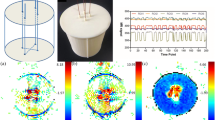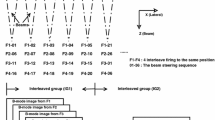Abstract
Objective
To propose a new method of simulating the BOLD contrast using a dynamic, easy to construct and operate, low-cost physical phantom.
Materials and methods
A structure of thin pipelines passing through a gel volume was used to simulate blood vessels in human tissue. Quantitative T2*, R2* measurements were used to study the signal change of the phantom. BOLD fMRI experiments and analysis were performed to evaluate its potential use as an fMRI simulator.
Results
Experimental T2*, R2* measurements showed similar behavior with published references. BOLD contrast was successfully achieved with the proposed method. In addition, there were several proposed parameters, like the angle of the phantom relative to B0, which can easily adjust the signal change and the activation area. Coefficients of variation showed good reproducibility within a month period. Statistical t maps were produced with in-house software for the BOLD measurements.
Discussion
T2*maps and BOLD images confirm the potential use of this phantom as an fMRI simulator and also as a tool for studying sensitivity and specificity of BOLD sequences/algorithms.








Similar content being viewed by others
References
Ogawa S, Lee T-M, Nayak AS, Glynn P (1990) Oxygenation-sensitive contrast in magnetic resonance image of rodent brain at high magnetic fields. Magn Reson Med 14:68–78
Ogawa S, Lee TM, Kay AR, Tank DW (1990) Brain magnetic resonance imaging with contrast dependent on blood oxygenation. Proc Natl Acad Sci U S A 87:9868–9872
Pauling L, Coryell CD (1936) The magnetic properties and structure of hemoglobin, oxyhemoglobin and carbonmonoxyhemoglobin. Proc Natl Acad Sci 22:210–216
Liau J, Liu TT (2009) Inter-subject variability in hypercapnic normalization of the BOLD fMRI response. Neuroimage 45:420–430
Hennig J, Speck O, Koch MA, Weiller C (2003) Functional magnetic resonance imaging: a review of methodological aspects and clinical applications. J Magn Reson Imaging 18:1–15
Friedman L, Glover GH (2006) Report on a multicenter fMRI quality assurance protocol. J Magn Reson Imaging 23:827–839
Olsrud J, Nilsson A, Mannfolk P, Waites A, Ståhlberg F (2008) A two-compartment gel phantom for optimization and quality assurance in clinical BOLD fMRI. Magn Reson Imaging 26:279–286
Cheng H, Zhao Q, Duensing GR, Edelstein WA, Spencer D, Browne N, Saylor C, Limkeman M (2006) SmartPhantom - An fMRI simulator. Magn Reson Imaging 24:301–313
Renvall V, Joensuu R, Hari R (2006) Functional phantom for fMRI: A feasibility study. Magn Reson Imaging 24:315–320
Chen T, Zhao Y, Jia C, Yuan Z, Qiu J (2020) BOLD signal simulation and fMRI quality control base on an active phantom: a preliminary study. Med Biol Eng Comput 58:831–842
Peters AM, Brookes MJ, Hoogenraad FG, Gowland PA, Francis ST, Morris PG, Bowtell R (2007) T2* measurements in human brain at 1.5, 3 and 7 T. Magn Reson Imaging 25:748–753
Laubach HJ, Jakob PM, Loevblad KO, Baird AE, Bovo MP, Edelman RR, Warach S (1998) A phantom for diffusion-weighted imaging of acute stroke. J Magn Reson Imaging 8:1349–1354
Boursianis T, Kalaitzakis G, Pappas E, Karantanas AH, Maris TG (2021) MRI diffusion phantoms: ADC and relaxometric measurement comparisons between polyacrylamide and agarose gels. Eur J Radiol 139:109696
Yablonskiy DA, Haacke EM (1994) Theory of NMR signal behavior in Inhomogeneous Tissues: The Static. Magn Reson Med 32:749–763
Yablonskiy DA, Reinus WR, Stark H, Haacke EM (1997) Quantitation of T2’ anisotropic effects on magnetic resonance bone mineral density measurement. Magn Reson Med 37:214–221
Lee J, van Gelderen P, Kuo LW, Merkle H, Silva AC, Duyn JH (2011) T2*-based fiber orientation mapping. Neuroimage 57:225–234
Bender B, Klose U (2010) The in vivo influence of white matter fiber orientation towards B0 on T2* in the human brain. NMR Biomed 23:1071–1076
Oh SH, Kim YB, Cho ZH, Lee J (2013) Origin of B0 orientation dependent R2* (=1/T2*) in white matter. Neuroimage 73:71–79
Maris TG, Damilakis J, Sideri L, Deimling M, Papadokostakis G, Papakonstantinou O, Gourtsoyiannis N (2004) Assessment of the skeletal status by MR relaxometry techniques of the lumbar spine: Comparison with dual X-ray absorptiometry. Eur J Radiol 50:245–256
Maris TG, Papakonstantinou O, Chatzimanoli V, Papadakis A, Pagonidis K, Papanikolaou N, Karantanas A, Gourtsoyiannis N (2007) Myocardial and liver iron status using a fast T2* quantitative MRI (T2*qMRI) technique. Magn Reson Med 57:742–753
Kalaitzakis GI, Papadaki E, Kavroulakis E, Themistoklis B, Konstantinos Marias TGM (2019) Optimising T2 relaxation measurements on MS patients utilising a multi-component tissue mimicking phantom and different fitting algorithms in T2 calculations. Hell J Radiol 4:18–31
Parrish TB, Gitelman DR, LaBar KS, Mesulam MM (2000) Impact of signal-to-noise on functional MRI. Magn Reson Med 44:925–932
Schenck JF (1996) The role of magnetic susceptibility in magnetic resonance imaging: MRI magnetic compatibility of the first and second kinds. Med Phys 23:815–850
Posse S, Wiese S, Gembris D, Mathiak K, Kessler C, Grosse-Ruyken ML, Elghahwagi B, Richards T, Dager SR, Kiselev VG (1999) Enhancement of BOLD-contrast sensitivity by single-shot multi-echo functional MR imaging. Magn Reson Med 42:87–97
Acknowledgements
Part of this work was financially supported by a research project entitled: “Conversion and Calibration of Magnetic Resonance Imaging System (MRI) in a measuring system of hyperthermia applications, using magnetically labelled nanoparticles", Acronym: MRI-TEMPERATURE, Operational Program: Competitiveness, Entrepreneurship and Innovation, EPANEK 2014-2020, “Research Create and Innovate” (EYDE-ETAK Code: PSKE T1ΕΔΚ-00149, OPS 5029590).
Author information
Authors and Affiliations
Contributions
TB: conceptualization, formal analysis, investigation, validation, writing—review & editing. GK: conceptualization, formal analysis, investigation, writing—review & editing. GG: writing—review & editing, AHK: writing—review & editing, supervision. EP: writing—review & editing, supervision. TGM: writing—review & editing, visualization, supervision.
Corresponding author
Ethics declarations
Conflict of interest
The authors declare no conflicts of interest.
Ethical approval
Ethical approval is not applicable in this phantom study.
Additional information
Publisher's Note
Springer Nature remains neutral with regard to jurisdictional claims in published maps and institutional affiliations.
Rights and permissions
About this article
Cite this article
Boursianis, T., Kalaitzakis, G., Gourzoulidis, G. et al. Introduction of a new simple dynamic phantom for physical BOLD effect simulation. Magn Reson Mater Phy 35, 389–399 (2022). https://doi.org/10.1007/s10334-021-00968-3
Received:
Revised:
Accepted:
Published:
Issue Date:
DOI: https://doi.org/10.1007/s10334-021-00968-3




